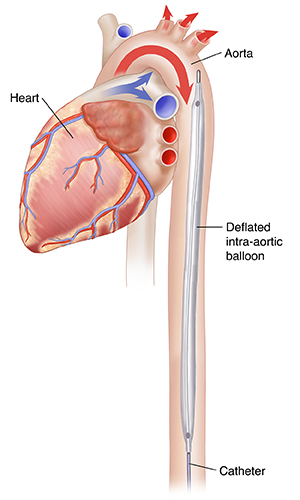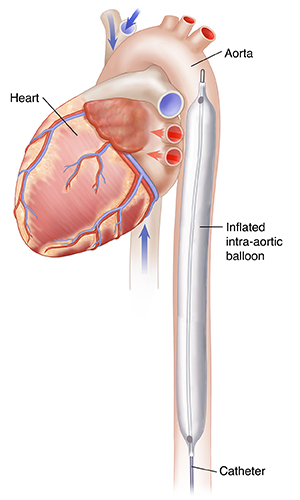Having Intra-Aortic Balloon Pump Therapy
An intra-aortic balloon pump (IABP) is a device that helps your heart pump more blood. You may need it if your heart is unable to pump enough blood for your body. An IABP improves blood flow to the coronary arteries and into the heart muscle. This decreases how hard the heart has to pump to get blood out to the body by decreasing the pressure the heart has to pump against.
In many cases, this procedure is done through a large IV (intravenous) line placed in the inside of your upper leg. Your healthcare provider will insert the balloon pump catheter into an artery in your leg. They will then guide it to your aorta. The device has a balloon that will inflate when the heart relaxes. This can increase blood flow to the heart arteries and muscle. When the heart squeezes, the balloon deflates. This allows an increased forward blood flow. This therapy is used when the heart is in shock and often when a person is critically ill or at very high risk of having a procedure on the heart to provide extra support. This device is often used with IV medicines that also help the heart function and support circulation. Not all people who have a balloon pump inserted are alert because they are critically ill. This procedure is not done in an outpatient setting and any person with a balloon pump will be watched very closely in an intensive care unit.


What to tell your healthcare provider
Be sure to tell your healthcare provider if:
-
You are pregnant or think you could be
-
You have other health conditions
-
You have ever had a problem with medicine to help you relax (sedation)
-
You have new symptoms, such as a fever
-
You have known blockages of arteries in your legs
Getting ready for your procedure
Before your procedure, your healthcare provider will give you detailed instructions. If you smoke, you should stop before your procedure. You may also need to stop taking any medicines, vitamins, or other supplements. You may also be given some new medicine to take before and during the treatment. This may include medicine to help prevent blood clots.
On the day of your procedure
IABP therapy is most commonly done during another type of heart surgery or procedure. In an emergency, a medical team may insert it at your bedside.
Each person’s procedure can vary. Your healthcare provider can tell you how yours will be done. In general, you can expect:
-
You’ll be given anesthesia. If you are having the procedure during surgery, you may already be under general anesthesia. In that case, you will be asleep and won’t feel anything. In other cases, you may get medicine to help you relax. You will also get numbing medicine at the insertion site.
-
During the procedure, your heart rate, blood pressure, pulses, and other vital signs will be watched.
-
The surgeon or cardiologist will insert an IV line into an artery in the upper part of your inner thigh. The balloon catheter will be inserted there.
-
The surgeon or cardiologist will gently push the catheter to a part of the aorta in your chest. They will use continuous X-ray imaging to track the movement of the catheter.
-
The balloon will be programmed to inflate when your heart relaxes. It will deflate when your heart contracts.
-
The surgeon or cardiologist will secure the end of the catheter usually using a stitch, so it stays in place.
After your procedure
You may need to have the pump for several days, but this is a short-term therapy. Your leg will have to be kept straight for the duration of therapy. You will not be able to stand or walk around while the IABP is in place. Your healthcare provider will watch you. X-rays may be done to make sure of correct placement. They may turn the pump off for a short time to see how your heart responds. Or they may set it to inflate and deflate with only every second or fourth heartbeat. When your heart pumps well on its own, you may be ready to stop the IABP therapy. Or you may stop the therapy when another treatment becomes available. Or a longer-term solution is needed if the heart is not recovering with medicines and the IABP. Situations such as this usually need a heart transplant, a ventricular assist device (VAD), or palliative care and hospice therapy based on a person's wishes for long-term life support.
Blood thinning medicines can be used to prevent blood clots from forming on the catheter and balloon. Circulation in the extremity will be watched very closely along with the function of the pump and the insertion site. This is to make sure there are no complications that develop because of the therapy.
Complications of the IABP include:
-
Poor blood flow through the artery the pump is inserted into
-
Poor blood flow to the leg
-
Clots on the balloon and catheter
-
Mistiming of the balloon inflation
-
Increased stress on the heart
-
Rupture of the balloon
-
Incorrect positioning of the balloon, which could harm the aorta or kidneys
-
Low platelet count
-
Infection
-
Stroke
When it's time to remove the pump, you will likely get medicine to help you relax. Your healthcare provider will then remove the catheter and the balloon from your leg. Manual pressure will be applied to prevent bleeding from the access site. The leg will need to be kept straight for 6 hours.
Your healthcare provider may give you more directions. Follow these carefully to help increase your chance of a good outcome.